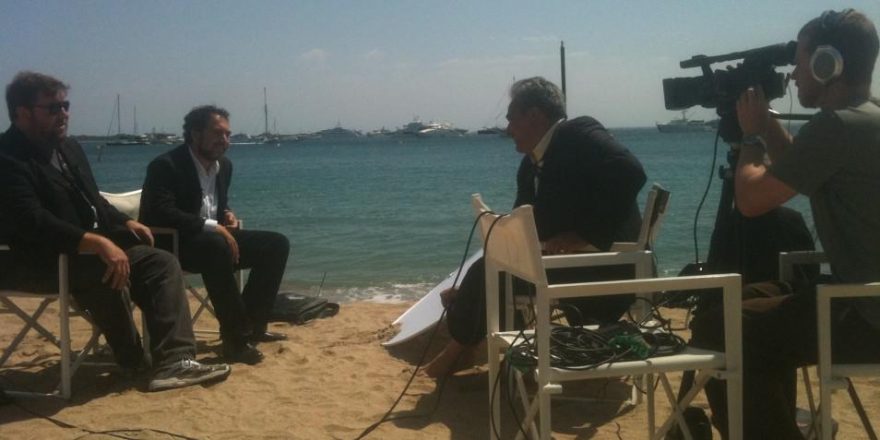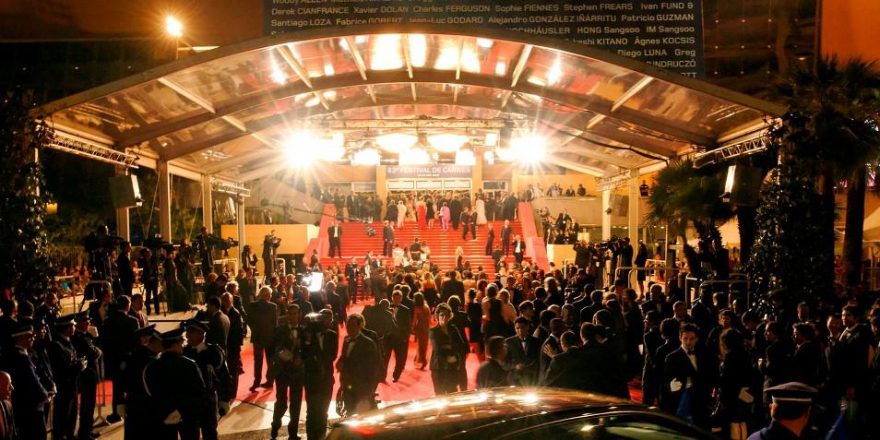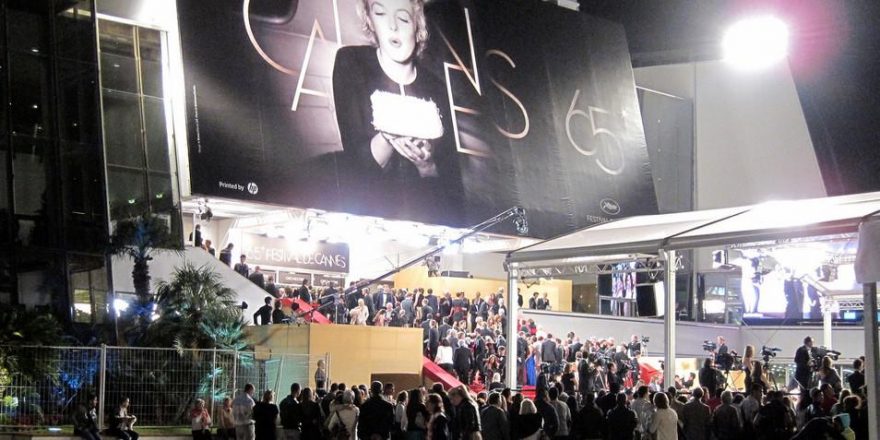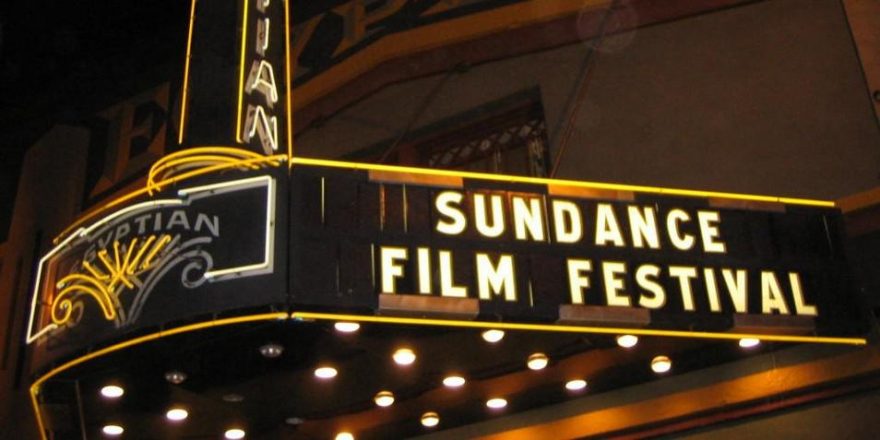Rodney Ascher
When Room 237 played at Cannes’ Directors’ Fortnight, I was automatically nominated for a Camera (spoiler alert: I didn’t win). This added an extra layer of anxiety and insanity to an already almost overwhelming experience.
One of the many perks that came with the nomination was a walk on the red carpet before one of the big movies, in this case Walter Salles’ On the Road with Kristen Stewart. We were told to meet in a private reception room at the top of the Palais de Festival early in the evening and we’d all be led to the premiere together.
Although it was suggested to me that I might want to bring a model or actress with me as my date, I opted to take my wife and we got dressed up (her in a nice dress, me in a thrift-store tux that dated from the ’70s) and we made our way to the top floor. We had time for a very good champagne with the other nominees and their dates — there must have been at least 30 of them, if memory serves — and we were all a little dazed by the whole experience.
At a certain point, an older man in finely tailored formal wear (was he wearing a sash or is that just in my imagination?) and an incredibly focused younger woman in a turquoise gown lined us up two by two and led us in a stately procession through the Palais, past curious onlookers and down multiple escalators until we got to the street level.
Things took a turn there — outside the doors, the path to the red carpet was chaos. The first thing I saw as we pushed into the crowds was a gauntlet of beautiful, sharply dressed young people holding signs that read something like “Take me! Take me!” Best I could tell, these young women (and a smattering of men) were hoping a single red-carpet traveller would pluck them out of the crowd and whisk them off to the premiere and then… who knows? There are less spontaneous, romantic ways to meet.
Next thing I noticed were the cops holding back gawkers and uncredentialed photographers — our escorts put on their game faces and struggled to keep our line together as we made our way to the periphery of the carpet. Soon, the throbbing crowd and flashing lights thoroughly dispersed our party and nearly separated my wife and I. As we got to the edge of what now seemed like a cattle chute on the killing floor, a man with an earpiece and a headset microphone frantically waved us to the sideline and then after counting to 10, the carpet.
As we blinked and walked forward, things were strangely bright and eerily quiet for a moment. It was gigantic and we weren’t quite sure where to go. We had been told our names would be announced and we’d take a moment to smile for the cameras before walking up the monumental stairway to the theater, but all we heard was a dull roar. And then came the shouting. First a single voice, then more, then seemingly hundreds of people were screaming abuse at us. I looked over to see row upon row of outraged paparazzi, stacked on bleachers, furiously waving us off the carpet and shouting, “S’en aller! Se’n aller!” or some equivalent of “Get the HELL out of here!”
Not that I expected a wave of excitement about our arrival or anything, but weird, right? Then I looked up at the Jumbotron above us — Robert Pattinson was now stepping on to the carpet; he was at the festival with Cosmopolis and he had shown up to support his Twilight co-star. We were not just nobodies, we were blocking the photographers’ line of sight to a celebrity whose picture was actually worth something, and they loathed us for it. It might’ve been fun to stand and smile and play dumb but neither of us really had it in us to stand up to that gale-force hate and we skedaddled up to the entrance.
Somehow, in the space of about 10 minutes I had travelled from a professional high to a public low, from being honored to being despised. It was sensational.
Rodney Ascher’s The Nightmare opens June 5 through Gravitas Ventures; you can watch the trailer here.
Lloyd Kaufman
At Cannes in 1983, I Had a Joycean Epiphany About The Toxic Avenger
We originally planned a conventional horror film. Ever since working on Rocky, Michael Herz and I had been interested in setting a film in a health club. Like Hitchcock, who set terrifying situations in banal locations, we thought we could do the same with the horror genre. I wanted to deal with America’s mania for creating young, beautiful bodies. Plus, I knew we could think of ways to have those weights really do some damage.
The basic concept was simple. There would be a monster in the health club who instead of killing good people killed bad people. (This harks back to the script I wrote with Stan Lee in 1971, Night of the Witch, where the witch only kills bad people.) Despite the various sexual proclivities of the characters in Friday the 13th, they were still good people for whom you rooted. We wanted our film, which we started calling Health Club Horror, to be different. The other thing we knew we wanted was a disgusting-looking monster.
So I spent a few weeks mulling over the different possibilities in my mind. But nothing seemed to click. It didn’t feel right. The idea of a horror movie seemed so good when we first thought of it, but now it was fraught with problems. First, if the monster was bad and the people it was killing were bad, why would the audience care? Sure, the gore and violence might keep folks enchanted for a while, but no matter what, a movie needs characters the audience cares about for it to be successful. Second, the movie just seemed so done. It was 1983, and low-budget slasher horror films with hideous monsters had been put out there time and time again through such fare as Funhouse and My Bloody Valentine. Certainly others, like Halloween, were minor masterpieces. I didn’t want to have to do the same thing everyone else had, but besides the fact of intermixing the horror theme with the health club, I couldn’t think of a way of making it original.
I would roll these problems around in my head constantly; while taking a shower in the morning, while jogging to work, while having business meetings, while changing Lily Hayes’ diapers, while being interviewed about The First Turn-On. I thought so hard my brain hurt. Noting, nada, zip. My career, I thought, is over (this thought comes to me a lot, in case you’re noticing a trend).
An Answer Appears
The Cannes Film Festival, 1983. I was on my way to a meeting with a Venezuelan distributor who controlled about half of that country’s theatrical and video markets when I suddenly stopped. I stood completely still in front of the Carlton Hotel, where the Troma business office was. People rushed past me on both sides: beautiful women, aging execs with sunglasses and too much tanning lotion, wannabe stars, boobs in gray suits, and boobs jumping out of halter tops.
“Make it a comedy,” my brain said to myself.
“Not a bad idea,” myself said to my brain.
“You’ve gone in the wrong direction,” said my brain. “Of course you can’t make a horror-monster-slasher movie like everyone else. It doesn’t interest you. But if you make it a comedy — now that could be something to sink your teeth into.”
Finally, after all the thinking, I had squeezed something out of my slightly impaired slice of gray matter.
I jogged back up to the Troma office. Michael Herz was there with a Japanese man who, for some reason, was wearing a hillbilly’s straw hat.
“Michael, I have the answer,” I said.
“Why aren’t you with Mr. Blanco?”
“Never mind that. Listen—”
“Never mind that?! You were supposed to be there 10 minutes ago!”
“We should make it a comedy.”
“What?”
“Health Club. We should make it funny.”
“Not scary?”
“Exactly.”
Michael’s eye lit with the fire of religion. He saw it too. We were going to make a horror-comedy.
“American comedies,” said the Japanese man in the straw hat, “are funny!”
Joycean Epiphany
From there, the pieces of the puzzle came together. This often happens on a creative journey when the project begins to gel. You think long and hard. There seems to be no answer. But, if you remain open and fearless, and go to the very edge with an idea, all the elements that initially seemed so disparate conjoin and become one.
Now it seemed so simple: The movie could still take place in a health club, which seemed a more natural place for a comedy than a horror film. In addition, the monster’s ability to sense evil now made sense: He would be good. This would finally give us someone to root for. The monster would be the hero. I jumped for Joyce!
The above is an excerpt from the book All I Need to Know About Filmmaking I Learned From The Toxic Avenger by Lloyd Kaufman and James Gunn, published here by permission of the authors. For more Tromatic tales of Cannes, check out the documentary All The Love You Cannes for free on YouTube.









